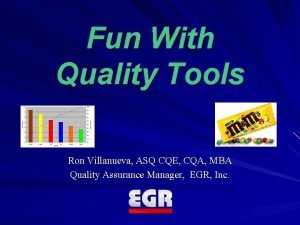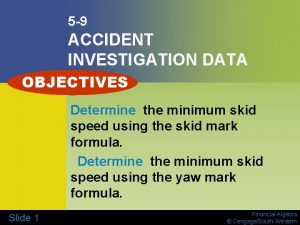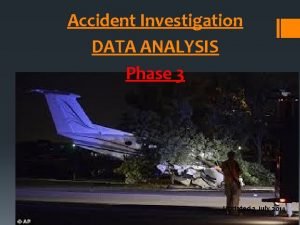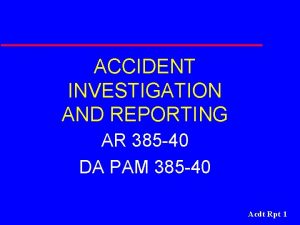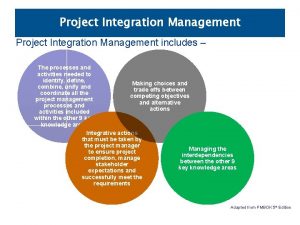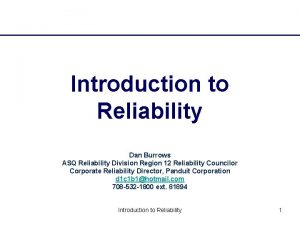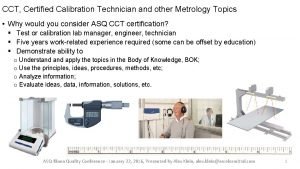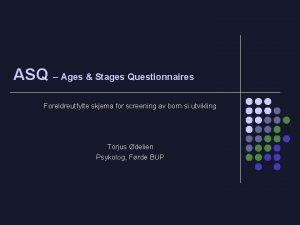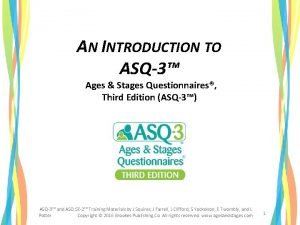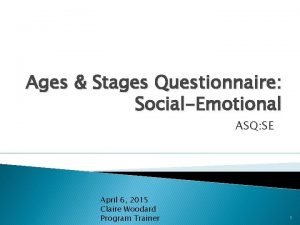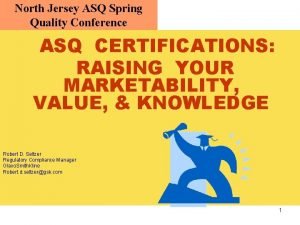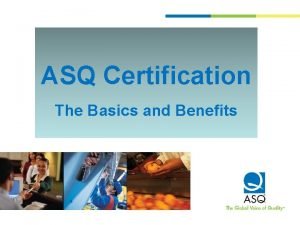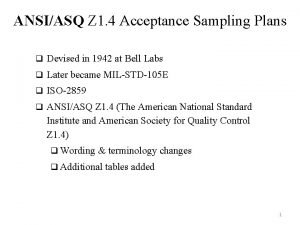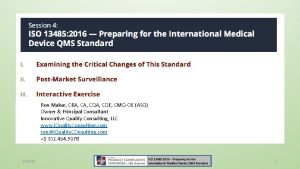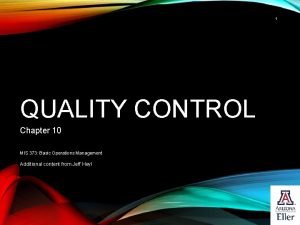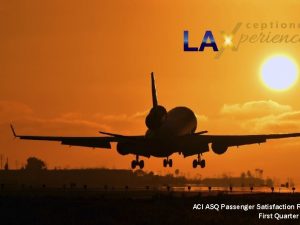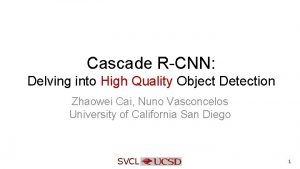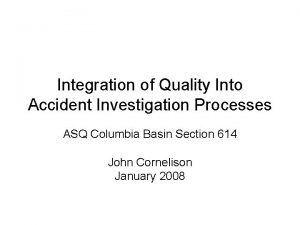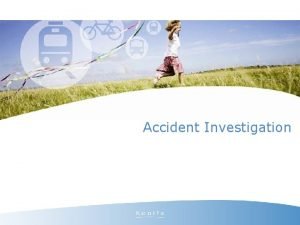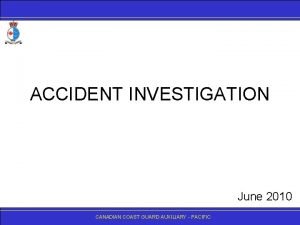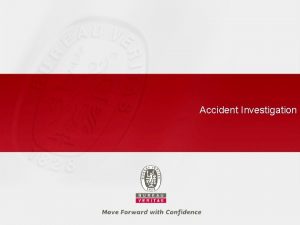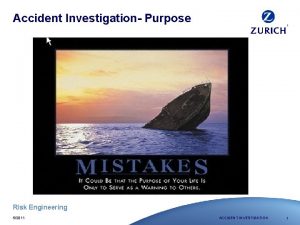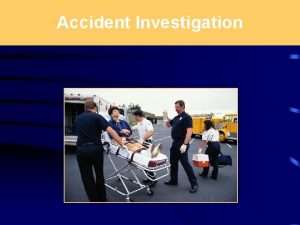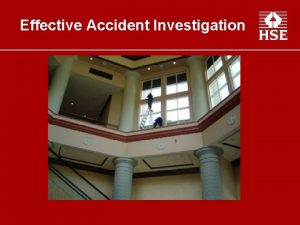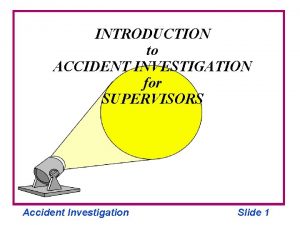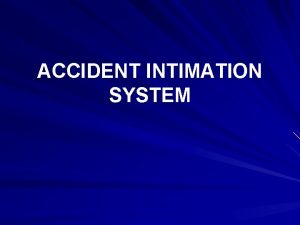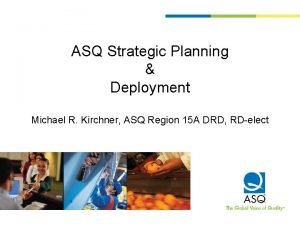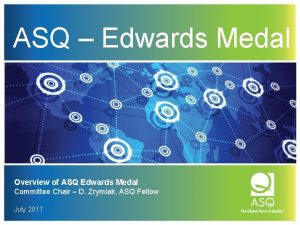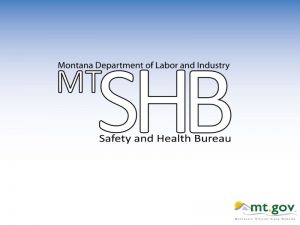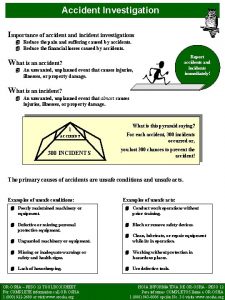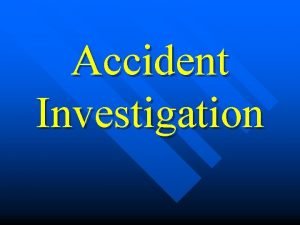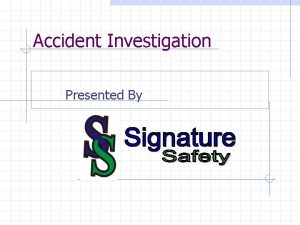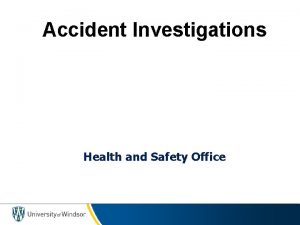Integration of Quality Into Accident Investigation Processes ASQ


































- Slides: 34

Integration of Quality Into Accident Investigation Processes ASQ Columbia Basin Section 614 John Cornelison January 2008

Failure of weld on blow down system

Presentation Summary • Outline system processes for investigation, analysis and reporting • Identify quality points

Key Elements of Accident Investigation • • Reconstruct what happened Collection of information Analysis of facts Determine why it happened Develop findings Decide on recommendations Write report

Performance Logic • The investigation and analysis processes should produce a finished report • Investigation and analysis information (facts) should be ready for the final report • Information is filtered through a group of causal factors • The investigator needs to place the information in the right report sections

Quality Considerations For AI Processes • Written plan and procedures and personnel trained to them • Experienced investigators • Decisions based on facts and not hearsay • Information and evidence collected controlled • Findings and conclusions based on facts • Recommendations address both Systemic Management findings and Specific work findings • Use of AI Model to drive processes

Advantages of System Approach • Accidents are complex • Divides accident information into usable elements • Focuses on critical barriers and controls • AI Model ensures minimum processes • Structured process for traceability and reliability • Reduces bias

Accident Model 1) Management Policy drives which barrier and controls used 2) Barriers and controls must be maintained Sequence of Events - Pre Accident - Post Accident Energies Barriers Controls Targets Accident Causal Factors Change - Prior - Present 6) Management must control changes 5) Management must maintain work processes in an operational readiness state 3) Multiple barriers and controls must be used 4) Management must maintain performance acceptable level Task Performance - Adequate - LTA Status of Work Process - Personnel - Procedures - Hardware - Environment OR

AI Model Quality Points • Are your current causal analysis and recommendations preventing similar accidents? • Causal factor selection may be LTA • Implementation of recommendations may be LTA • System for investigation and analysis may need to be changed

Sequence of Events • Accidents involve a sequence of events that set up LTA conditions – work planning • Investigation method – Event Charting • Recreates sequence of events, what happened • Systemic and specific conditions and causal factors • Is the system functioning as planned

Quality Points • Sequence of events in correct order based on time and date • Requires a complete investigation to ensure correct order • Looks at both systemic and specific events • Identifies missing sequences • Where did the Systemic and Specific failures occur; in work planning, in implementation or in control processes


Barriers and Controls • All accidents involve failure of barriers and controls • Investigation Method – Barrier Analysis • Identifies energy sources, physical barriers, administrative controls and targets • Evaluates effectiveness of barriers and controls • Determines reliability of barriers & controls

SYSTEMS APPROACH TO ACCIDENT INVESTIGATION BARRIER ANALYSIS Energies/Hazard Physical Barriers Administrative Controls Targets/Value Evaluate B&C

Quality Points • Identifies all the hazards • Separates physical barriers from administrative controls • Examines mode of failure • Identifies all potential targets of value – Personnel, Facilities, Processes, Environment

Task Performance • Accidents involve work performed which is adequate or LTA • Investigation Method – Task Analysis • Identifies basic tasks • Looks for task errors • Analyzes task errors for “Can Do” and “Motivational Behavioral Climate” • Questions methods to ensure performance

SYSTEMS APPROACH TO ACCIDENT INVESTIGATION TASK PERFORMANCE ANALYSIS Event No. Task Description Task Error Evaluate Task Error Risk Level

Quality Points • Identifies tasks with potential for errors that can degrade system • Identifies task with errors • Looks at how the task errors occurred in the work processes • Quality monitoring to ensure critical systems are not affected by task errors

Status of Work Processes • Accidents involve many work processes • Each process may be in a different state of readiness • Investigation Method – Status of the Work Process Review • Looks closely at personnel, procedures, hardware and environment in OR mode • Time and interfaces

SYSTEMS APPROACH TO ACCIDENT INVESTIGATION STATUS OF WORK PROCESSES ANALYSIS Event No. Personnel Procedures Hardware Environment OR Status Risk Level

Quality Points • Investigates the OR status of key elements of the work process – Personnel – Procedures – Hardware – Environment • Determines when and how the elements lost their OR status • Set up monitoring points

Change • Most accidents involve some type of change in the work processes • Investigation Method – Change Analysis • Identifies present conditions and prior conditions • Looks for differences • Analyzes changes for affects on setting up LTA conditions

SYSTEMS APPROACH TO ACCIDENT INVESTIGATION CHANGE ANALYSIS Present Condition Prior Condition Change/Difference Evaluate Affects of Change

Quality Points • Investigates how changes in the work processes were managed • Looks at planned and unplanned changes • Looks at the interface of the changes with the key elements of the work processes • Looks at how system performance was affected by the changes

Causal Factors • Reasons or whys for an accident • Investigation Method – Root Cause Analysis • Identifies Systemic and Specific causes • Looks at chain of causes from management to work and back to management • Groups causes into 27 categories

Systemic Factors • • • • Management Policy Implementation Risk Assessment Technical Information Hazard Analysis Safety Appraisals / Audits / Reviews Change Procedure Codes / Standards / Regulations Design Human Factors Quality Assurance / Quality Control

Specific Factors • • • • Amelioration Barriers & Controls Operational Readiness Maintenance Inspection Supervision Task Performance Personnel Training Environment Equipment Communications Personnel Protective Equipment

Systems Approach to Accident Investigation Causal Factor Analysis Selection Tree RC Number Causal Factor Categories Root Causes RC 1 Oversight RC 2 Omission RC 3 Assumed Risk Systemic Causal Factors RC 1 A Policy RC 2 A Policy Implementation RC 3 A Risk Assessment Specific Causal Factors DC 1 Barriers Physical Equipment Safety Systems Select 1 or more from RC 1 -3 Select 1 or more from RC 1 A-3 A Select 1 or more from DC 1 -3

DC 2 Controls Administrative Information/Communication Operational Ready Maintenance Inspection Supervision DC 3 Task Performance Perform Task Correctly Made Task Error Contributing Causal Factors CC 1 Personnel Criteria Fit For Duty Training Experience Motivated CC 2 Procedures Written Current Followed Match work process CC 3 Hardware Design Human Factors Hazard Analysis QA/QC CC 4 Environment Hot/Cold Vibration Noise Space Stress Select 1 or more from CC 1 -5

CC 5 Change Specific Changes CC 6 Programmatic Programs

Quality Points • Looks at a complete system of causes • Systemic and Specific • Identifies the complete chain of causal factors • Fixes not just the primary accident causes but all the LTAs in the system

Summary of The Processes • Use of the Systems Approach Accident Model to drive the investigation • Focuses on fixing all the LTAs in the system • Which prevents future accidents • Use of the systems analysis tools provides valid factual information to accident report • Maintains high level of performance

Accident Report • • • Title Page Table of Contents Executive Summary Facts Section Analysis Section Finding Section Recommendations Signature Appendix

Accident Model 1) Management Policy drives which barrier and controls used 2) Barriers and controls must be maintained Sequence of Events - Pre Accident - Post Accident Energies Barriers Controls Targets Accident Causal Factors Change - Prior - Present 6) Management must control changes 5) Management must maintain work processes in an operational readiness state 3) Multiple barriers and controls must be used 4) Management must maintain performance acceptable level Task Performance - Adequate - LTA Status of Work Process - Personnel - Procedures - Hardware - Environment OR
 Asq quality tools
Asq quality tools 5-9 accident investigation data answers
5-9 accident investigation data answers Accident investigation data analysis
Accident investigation data analysis Army ground accident report
Army ground accident report Concurrent processes are processes that
Concurrent processes are processes that Communication integration processes
Communication integration processes What is project integration management
What is project integration management Six processes of project integration management
Six processes of project integration management Asq world conference
Asq world conference Dan burrows attorney
Dan burrows attorney Certified calibration technician training
Certified calibration technician training Asq skjema
Asq skjema Asq se2 60 months
Asq se2 60 months Ages and stages questionnaire calculator
Ages and stages questionnaire calculator Asq north jersey
Asq north jersey Asq recertification
Asq recertification Asq sampling plan
Asq sampling plan Asq cba
Asq cba Asq 9100
Asq 9100 Asq control chart
Asq control chart Laxis happening
Laxis happening Loose solid particles
Loose solid particles Forward integration and backward integration
Forward integration and backward integration Forward backward integration
Forward backward integration Simultaneous integration and sequential integration
Simultaneous integration and sequential integration Perform quality assurance
Perform quality assurance Quality control vs quality assurance pmp
Quality control vs quality assurance pmp Pmbok quality assurance vs quality control
Pmbok quality assurance vs quality control Total quality management seminar
Total quality management seminar Quality improvement vs quality assurance
Quality improvement vs quality assurance Basic concepts of quality control
Basic concepts of quality control Quality gurus
Quality gurus Quality is free
Quality is free Old quality vs new quality
Old quality vs new quality Cascade r cnn
Cascade r cnn
